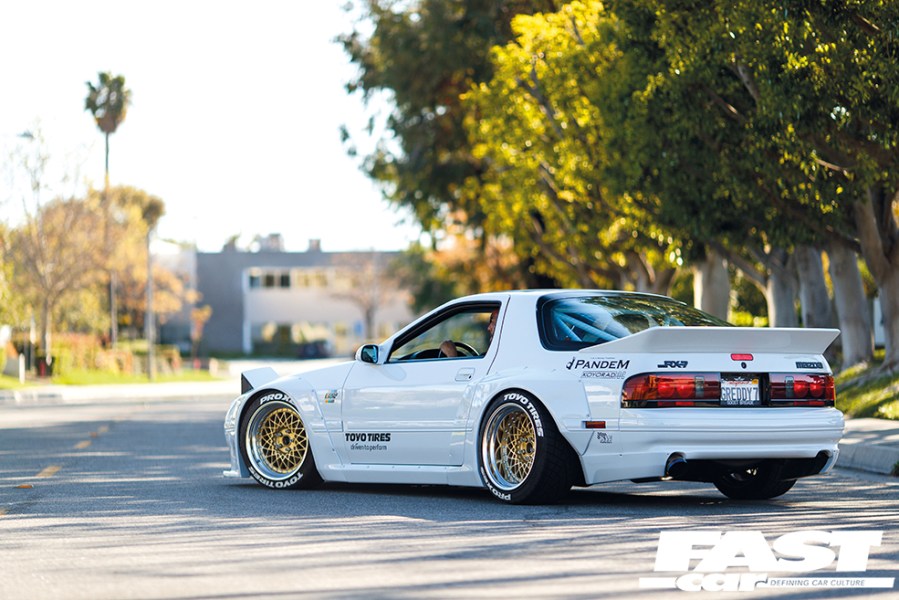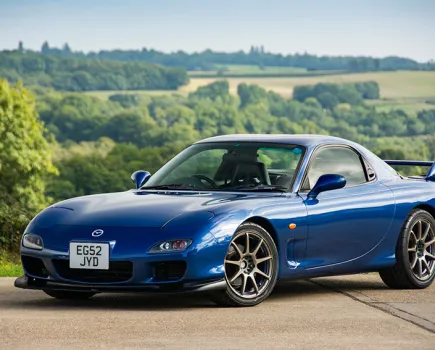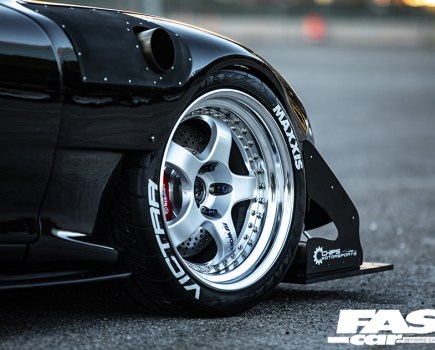From once being seen as the poor relation compared to its younger brother, the FD, the Mazda RX-7 FC has rapidly transformed in to a retro classic. We’ll take you through the RX-7’s tuning potential in this guide.
First appearing in the mid 1980s and continuing in production until the release of the FD in 1992, the FC3S was the second generation of Mazda’s iconic rotary powered sports car, the RX-7.
While various models of FC appeared over the years, there’s a few main variations to consider. Firstly, and most obviously, some didn’t have a roof! The FC is the only RX-7 model that had a factory convertible option, and they look pretty damn cool.
Beyond that obvious difference, people refer to early cars as Series 4s (S4) and later facelift models as Series 5s (S5). While all the S5 changes were considered upgrades, there are a few S4 parts (lower compression rotors and two piece front lower arms, for example) which can actually be an advantage when it comes to modification. Other big changes include different rear lights and a different turbo setup between S4 and S5 models. But, while S5s come with more power from the factory, when it comes to tuning, there’s no huge advantage either way.
While RX-7s in all forms have always been popular in motorsport, the FC is arguably the most used of them all. From drag racing to drifting, from rally to Le Mans, the FC has done it all and with a lot of success too. That 30+ years of motorsport, combined with a cult following in Japan and the USA, means that your tuning options are almost unlimited. So, without further ado, here’s our Mazda RX-7 FC tuning guide.

Mazda RX-7 FC Engine Tuning
There’s two main engine options from the factory with the FC, and that’s naturally aspirated or turbocharged versions of the 13B twin rotor engine. Earlier S4 versions made 146bhp naturally aspirated and 185bhp turbocharged, and later S5 models made 160bhp and 200bhp respectively.
Both N/A and Turbo S5 models had higher compression rotors than the S4 models, but most interestingly, the turbo models had very different turbo setups. The S4s came with a turbo manifold with what’s commonly known today as a quick spool valve. Incredibly uncommon in the OEM world and usually associated with tuning, this valve effectively blocks off one of two scrolls of the turbine housing of the turbocharger, making the turbo spool up very quickly, and then at a set boost pressure the valve would open, allowing full flow and full power. The S5 setup was much more conventional, using a true twin scroll turbo and manifold design which, thanks to the two rotor engine design with incredibly strong exhaust pulses, works brilliantly well, as good or better spool than the S4 setup, but with a simpler design and more maximum flow.
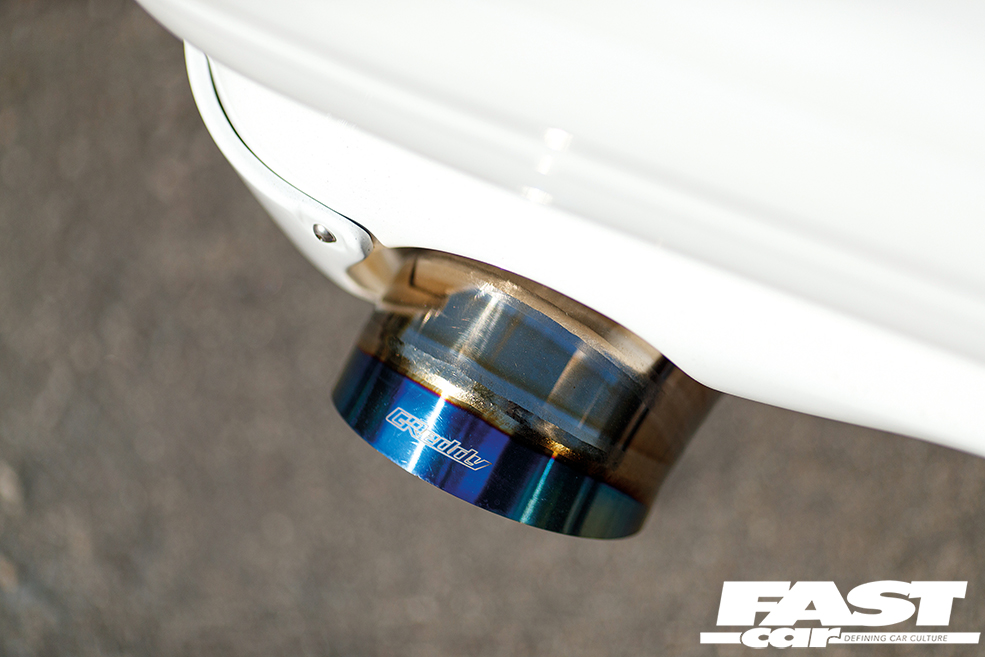
Mazda RX-7 FC Exhaust Tuning
All rotary engines, naturally aspirated and turbocharged, create a lot of exhaust flow, so a performance exhaust system is a must regardless of model. Countless companies, especially from the USA and Japan where these cars were the most popular, make systems for the turbo options. Though, UK-based Japspeed sell a nice 3-inch turbo-back system which is generally the easiest one to source if you’re in Britain.
As for the naturally aspirated versions, there are various systems available from US companies. But in the UK, unless you could source the now very rare Janspeed system (don’t confuse them with Japspeed), a custom made exhaust would be the way to go.
For N/A models, an uprated exhaust manifold is vital for any serious tuning. You can usually source one online from the USA relatively cheaply. The final thing to note is while all rotary engines are loud, without the turbocharger muffling the noise, N/A ones are extremely loud, so don’t underestimate how much silencing you’ll need to get the exhaust noise down to a sensible level!
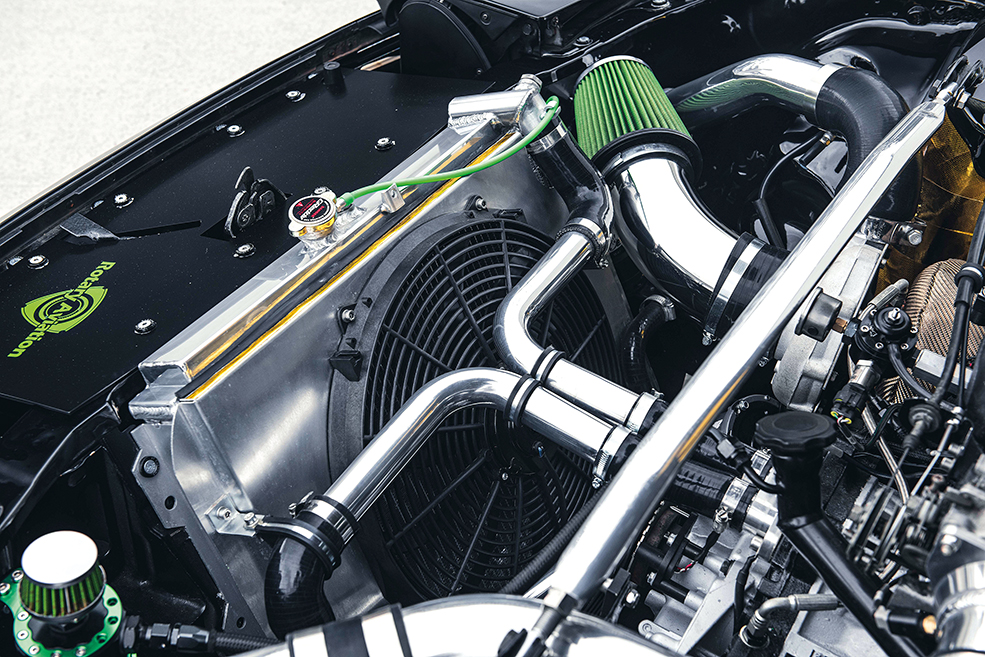
Mazda RX-7 FC Intake Tuning
With all FC models featuring a MAF sensor mounted on the end of the intake pipe relatively close to the front of the engine bay, the intake upgrade path is very simple. The vast majority of setups simply use a high flow cone filter bolted directly to the MAF sensor, though AutoEXE make a trick carbon shield/duct for their intake system, and many people create custom heat shields around their cone filter to try and reduce and hot air from the rest of the engine bay being sucked in.
Of course, when going beyond basic modifications to big turbos or screaming N/A motors, the intake tuning gets far more complex, but that’s covered later in this article…
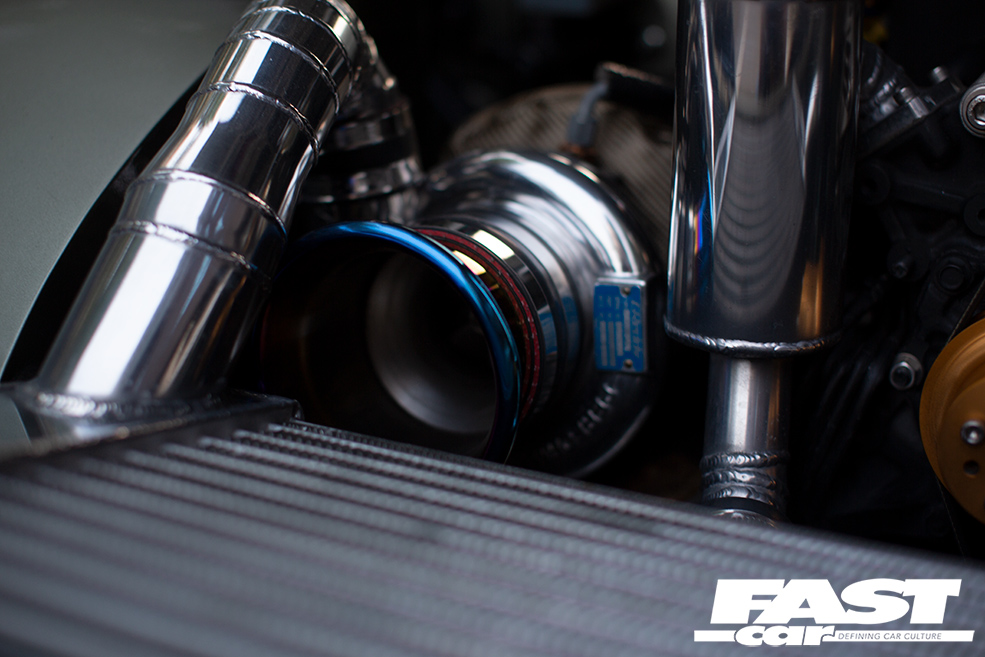
Mazda RX-7 FC Turbo Tuning
The factory FC turbocharger is the Hitachi HT18, and as standard turbochargers go, is quite a nice turbo, being of a twin scroll design and having a relatively high flow turbine wheel. When it comes to upgrades, the later S5 version is preferable, as the twin internal wastegates flow better to reduce the chance of boost creep, but to get worthwhile gains beyond a mild increase in boost pressure, you will need to get an upgraded compressor wheel fitted, as the standard item is very small. Mamba and others make larger billet wheels for the factory HT18, but it’s rare to see an upgraded factory-style turbo and manifold pushed to even 350bhp- Most go direct to a full aftermarket turbo setup.
Aftermarket Turbos
When it comes to turbo kits, the issue is similar to most parts for FCs, and that’s while almost every big Japanese tuner made them for the FC at one point, most are no longer in production so these can be hard to get, though some are still out there if you’re determined to get one. These kits range from mild to wild, with smaller HKS T04E turbo kits spooling up ultra fast but maxing out around 400 horsepower, right up to kits using T88s and T51Rs good for 800bhp+. In reality though, the best way to go is a more modern and still in production turbo setup, not only for availability, but the fact that times have moved on, so better turbo, manifold, and wastegate options are now available.
While single scroll setups certainly exist, twin scroll manifolds really are the best option, and for a bolt-on solution, Turbolown Engineering in the USA make one of, if not the best bolt-on turbo setups for FCs. They have compact twin scroll T4 tubular manifolds available in both non-wastegated form to use the BorgWarner EFR internal wastegate turbos, or manifolds with twin external gates to use the more common non-wastegated turbos. They also sell these as part of full kits, including turbo, wastegates, fuel system, downpipe, ECU, and even heat shielding! These full setups certainly aren’t cheap, but it’s never been easier to get a complete bolt-on 400-800bhp capable turbo setup for an FC.
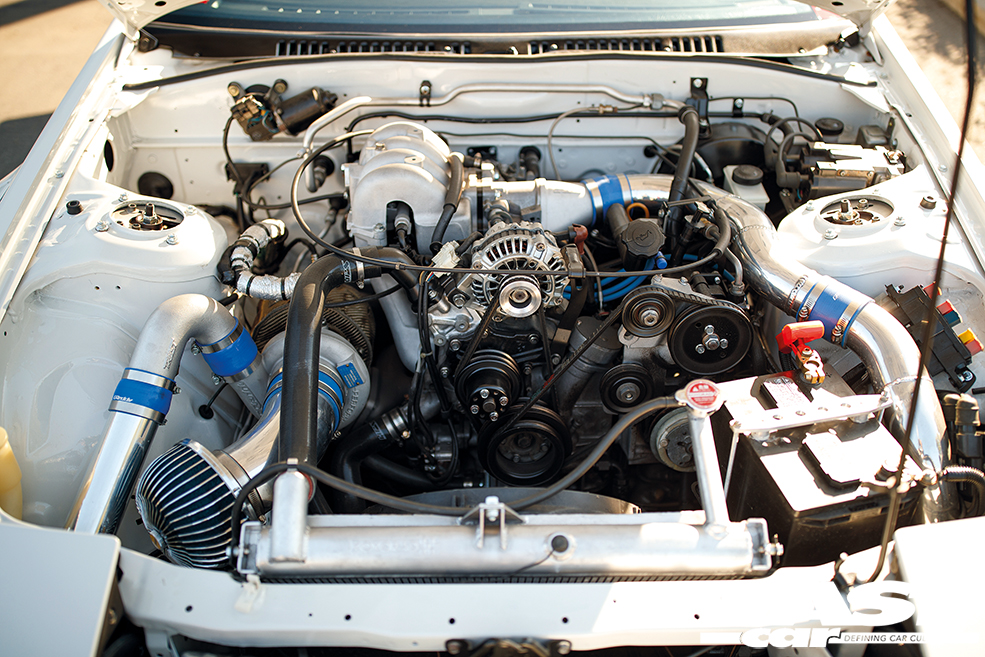
Fueling upgrades
The factory fuel injectors on FCs are relatively big, with the Turbo models getting 550cc injectors, and the naturally aspirated versions coming with 450cc injectors. While this sounds impressive, they may well be well over 30 years old by now so way past their best, and beyond the mild bolt-on upgrades, these are usually changed. Thankfully injector and fuel pump fitment is a very common design so upgrades are cheap and simple, whether you want to go for a small upgrade a setup for massive power levels.
For extreme levels, companies like Full Function Engineering sell aftermarket fuel rails for these, Built2Apex make twin 460lph in-tank fuel pump kits, and with Injector Dynamics making injectors up to 2600cc, i.e. over four times bigger than the already big standard injectors, even in stock position form there’s almost no power limit to the fuel system.
When going really, truly wild, such as cars running methanol guzzling drag engines, there’s even aftermarket inlet manifolds from the likes of ProJay available for the FC that, rather than the factory 4 injector design, have the capacity for 8 and even 12 injectors for truly insane amounts of fuel flow.
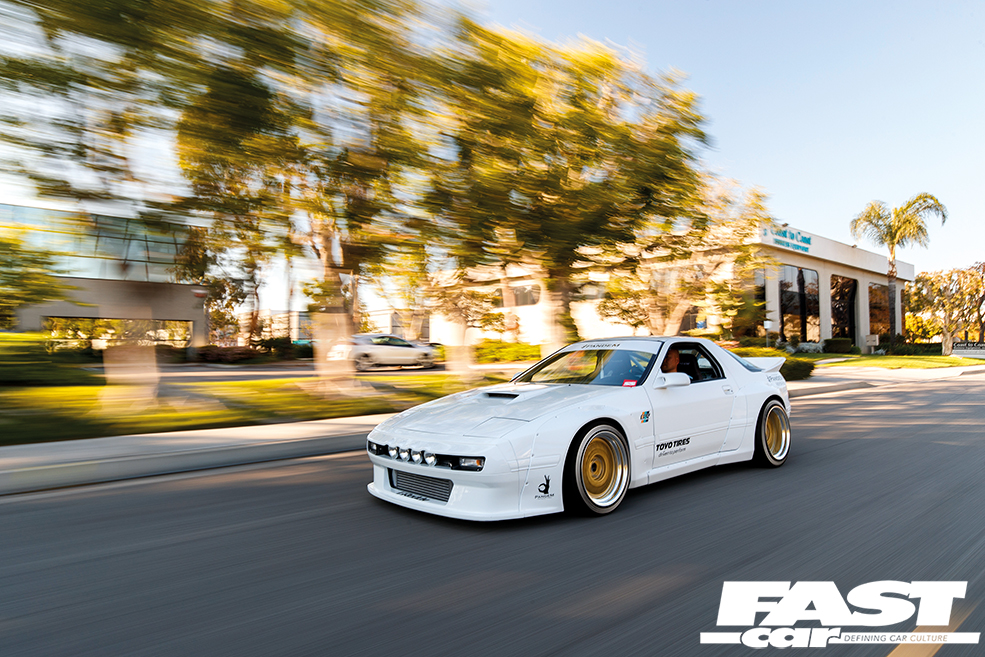
Mazda RX-7 FC ECU Upgrades
Just like most standard Japanese ECUs of this era, it’s hard if not impossible to modify them in any meaningful way, but there are a few things to take in to account even when doing mild upgrades with the factory ECU, specifically for the turbo models.
With lean running and detonation being the number one killer of rotary engines, we’d suggest fitting air/fuel ratio and boost gauges before any engine mods so you can at least have some idea that the factory ECU is working within its safe parameters.
As standard the FC runs very low turbo boost pressure, and when you fit a full turbo-back exhaust system it increases flow so much that your boost pressure increases also, usually making the car hit the factory fuel cut limit. The solution to this is a Fuel Cut Defender which is cheap and simple to fit device that allows more boost without the fuel cut happening, and therefore more power. Fitting an aftermarket boost controller generally isn’t wise at this level, as the boost will generally naturally rise to its safe limit, and adding more without control over the ECU to increase the fueling to match is not a good idea if you want your engine to live!
Standalone Aftermarket ECUs
While plug-and-play ECU kits have existed over the years for the FC, these are neither commonly available anymore and generally aren’t for modern engine management systems, so overall, especially as correct fuel and ignition timing is more important for reliability on a rotary than any other part, it really is worth going to a full custom wiring loom to suit your ECU of choice.
Going to a full aftermarket setup, as well as giving your tuner countless useful functions to use, allows you to get rid of other weak points of the factory FC electronics such as its ignition system and sensor designs, allowing you to run modern coils and trigger wheels, for a more reliable and predictable setup.
Last but certainly not least, your choice of tuner/mapper is key. Rotary tuning is very different to piston engines, and if you tried to tune them the same way it will end in tears quickly, so finding a tuner who’s proven to have a good track record of tuning rotary engines is vital.
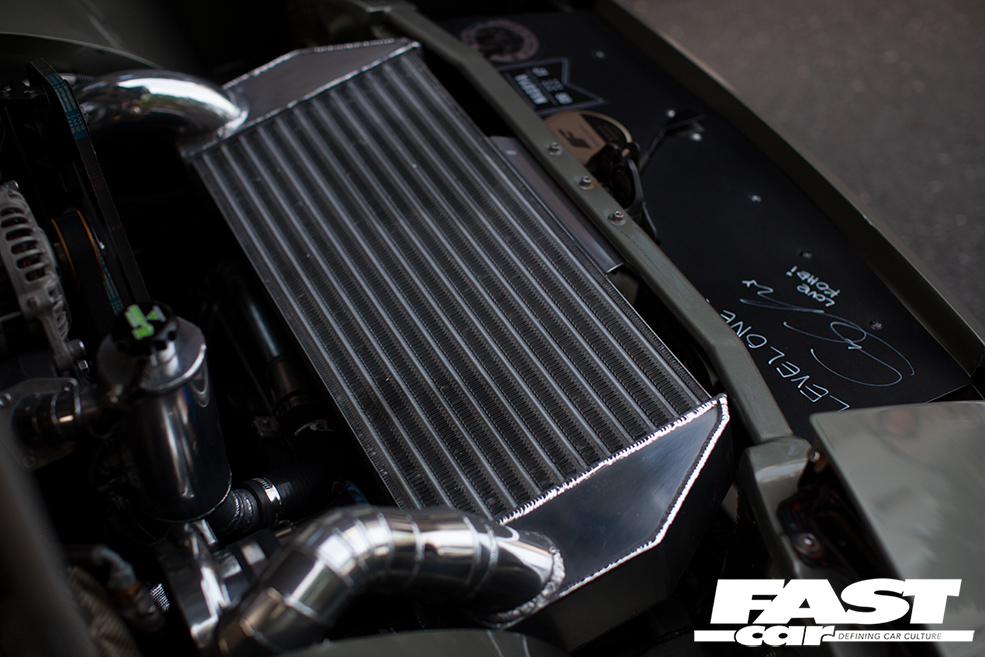
Mazda RX-7 FC Cooling Upgrades
Rotary engines do create a lot of heat, but thankfully their cooling system, if in good condition, copes well. Age is certainly a factor though, so a refresh of things like the radiator, water pump, and thermostat, and a quick upgrade to an aftermarket alloy radiator while you are at it, is a wise move. The factory FC oil cooler is actually very large, though for hard track use it’s not uncommon for drivers to add a second one to increase cooling. Be aware though, this can cause over-cooling in some setups, so don’t do it unless it’s truly needed.
One part of the cooling that really does need improving is the standard intercooler on the turbo models, as while the factory top mount just about copes on standard engines, an upgrade should be one of the first tuning mods you should do.
Uprated top mount intercoolers are available for the FC, but generally the benefits tend not to be enough for the cost and effort to do so. And besides, with low intake temps being a big benefit to reliability, going straight to a large front mount intercooler is the way to go. While there’s various kits out there, the unbranded but perfectly good front mount intercooler kits for the FC, including the throttle body adapter, can be found on eBay for a very low price and is generally absolutely fine even at the 500bhp level.
Water/Meth Injection
Another important thing for any tuned and boosted rotary is water/meth injection. While most think of these setups are for lowering the inlet air temps, their main help is lowering combustion temps inside the rotor housing, greatly reducing the chances of engine destroying detonation. Even a basic single nozzle kit from the likes of AEM, Aquamist, or Devils Own, is a relatively simple to fit upgrade that if set correctly is well worth the effort. The important factors to note is if you’re injecting just a nominal amount it really would be just a placebo, but conversely too much will cause an ignition misfire, so it’s a balance between the two.
The higher the percentage of the injected mixture that is methanol, the greater the amount that you can inject without causing a misfire. This is because, unlike water, methanol is a combustible fuel. Ignition system strength is a massive factor here also, as a stronger spark will happily fire even with large amounts of water injected. So, most people tend to upgrade these things at the same time.
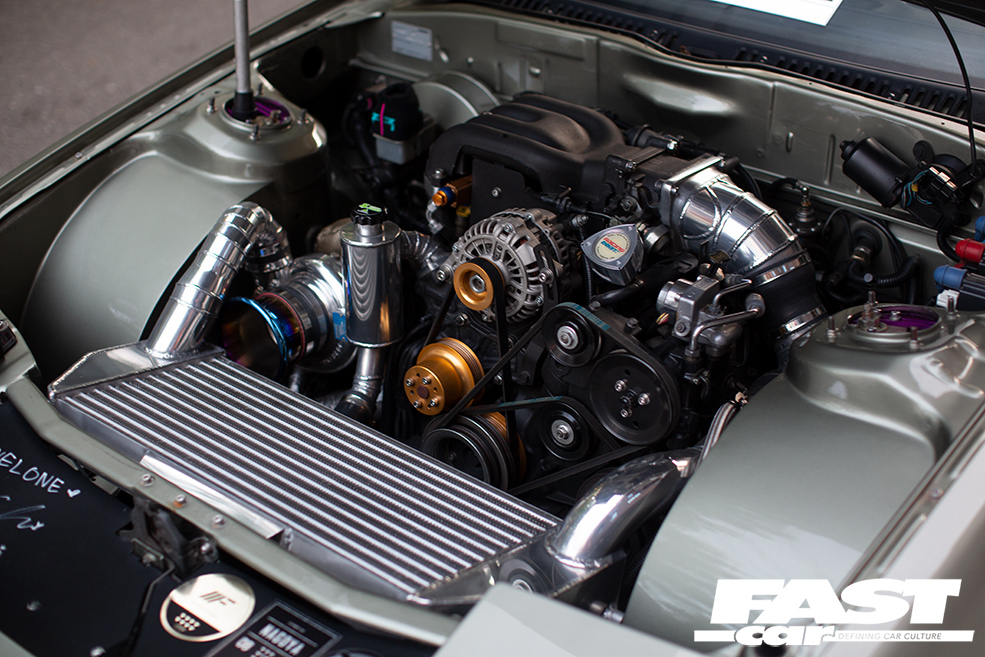
Mazda RX-7 FC Engine Internal Tuning
The rotary engine is wildly different to piston engines in almost every way, and while there’s just three independently moving parts in a two rotor, the rotors themselves and the eccentric shaft, there’s a number of small but no less important parts to take in to account.
These main parts are incredibly strong, with factory rotors, shafts, and their housings often used on even the most powerful rotaries out there. But, regardless of strength, one tuning mistake (which is easily done as rotaries have a much narrower tuning window than a piston engine), and you could destroy your engine.
This issue is not because of these main rotary engine parts, but because of the smaller but just as vital components, especially the infamous apex seals. While capable of handling incredible power, apex seals cannot survive a bad tune, and their failure tends to be the number one reason why a modified rotary – especially a boosted one – ends up going home on a recovery truck.
Apex Seals
Apex seals are the rotary equivalent of piston rings, the key component that gives the engine its compression. There’s countless variations of apex seals available, with harder ones able to withstand high temps and detonation a little better, but with the potential side effects of increased wear on housings and more damage to other components if they do fail. Some are very flexible, so if detonation does damage them, they simply bend rather than snap or shatter, causing less damage to other components. However, this can be a trade off in overall strength.
Porting
With no camshafts or valves on a rotary, the intake and exhaust ports don’t open as such. Instead, the rotor and its seals covers the ports as it moves around the casing. Because of this, you need to change the shape and size of the ports to adjust when they open, and for how long. The same is also true for their overall maximum flow rate. This is important for power increase on any rotary, but for the naturally aspirated versions, where you haven’t got a turbocharger forcing in the air, porting is absolutely vital for making any worthwhile power gains.
While it’s a very vague description, the four most common porting styles, in order of mild to wild, is: street port, bridge port, semi-peripheral port, and full peripheral port.
Street port means enlarging of the stock port design, and this can be anything from very small changes to significantly increasing their sizes and shapes, and street ports are very common as they give almost factory drivability and reliability.
Bridge Porting
For 500bhp+ turbo engines, and 220bhp+ N/A motors, a bridge port is normally the way to go. This is effectively a street port with a secondary long thin extra port just outside of it. The reason for it being two ports rather than one huge one, is the metal left between the two ports allows the rotors corner seals to travel across it, hence the name bridge. If there was nothing there the corner seal would simply fall out and the engine would not run. Idle quality and low rpm performance will again depend on how hardcore the porting has been, but most will have at least a slightly higher and lumpier than standard idle and less low rpm power, and some larger bridge setups are screaming high rpm monsters, with over 11,000rpm being possible on the right engine.
While a naturally aspirated rotary will require an aftermarket inlet manifold to realize the true gains of even a large street port, and certainly a bridge port, from this point onwards even the turbo models need a different inlet setup. Thankfully there’s a wide range available, especially from the USA, from conventional single throttle designs, to big 4-barrel intakes, and even independent throttle body setups.
Peripheral Porting
A semi-peripheral port is actually two more ports added via some machining to the rotor housing itself, rather than just using the original ports which are on the plates either side of the housing. These ports be of varying sizes depending on your goals, and the original intake ports will also generally be ported either street or bridge style. The advantage of semi-peripheral is of course more air flow, but if used in conjunction with a street port is it has the advantage over bridge ports of not potentially reducing corner seal reliability while still giving huge airflow levels.
The most extreme example is the full peripheral port. In this situation, tuners seal the factory side ports shut with high strength epoxy resin, such as Devcon. In its place, you then add a single huge intake port to each rotor housing. This large and direct route for the airflow is by far the best for power, but idle speed is often over 1500rpm and low down power is greatly reduced. This setup is usually reserved for extreme naturally aspirated rotary race engines, though it has been done in conjunction with turbocharging in a few examples.
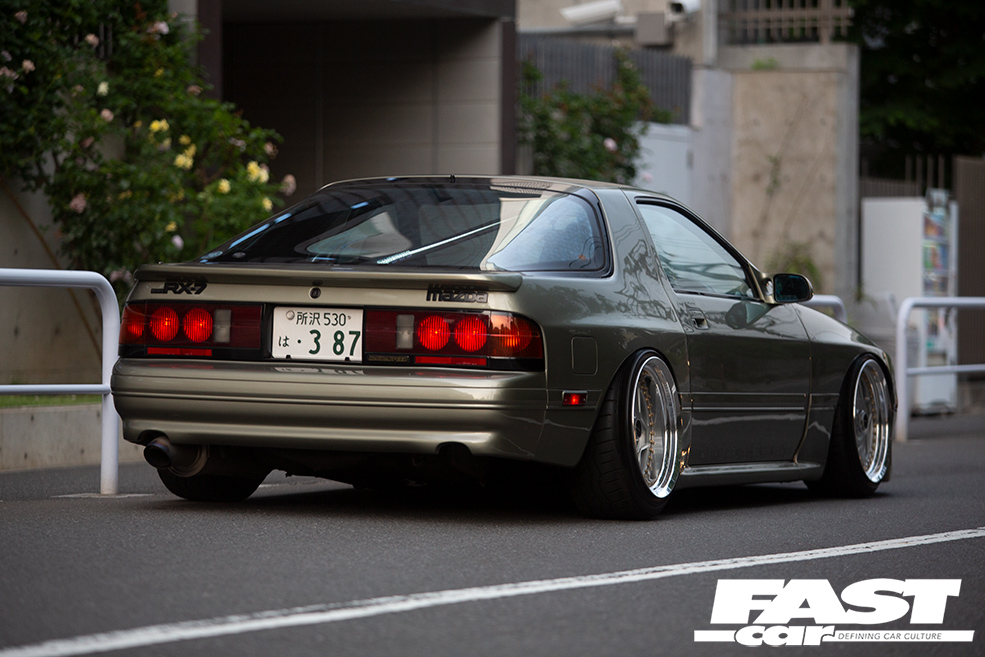
Engine Swaps for the FC RX-7
These days it’s probably no exaggeration to say that there are more FCs in existence with piston engine swaps than there are rotary originals. But, before we get in to them, let’s talk about swapping the factory 13B for something still rotary flavor, but a little more spicy.
First up, you can’t simply fit the FD RX-7 13B-REW engine into an FC. Even ignoring the complex factory twin turbo setup, the engine itself will simply not bolt up! While they are both 13B engines of very similar design with almost all parts being interchangeable, the engine mount design and bolt holes on the 13B differ so much between FC and FD versions that you’d need a lot of custom fabrication, including a new crossmember, to fit a FD engine in to a FC, and as all parts are interchangeable, unless access to the FC specific parts was impossible for you, it’s generally not considered worth it.
3 and 4 rotor swaps are possible if you have the budget for it, and those of you that are truly insane could technically pull off 5, or even 6, rotors. Though, you would need to make significant chassis changes to fit such a long engine into the FC bay!
Piston Swaps
Away from the rotaries, you name almost any piston engine and you’d probably find someone’s fitted one to an FC at some point. Ford and Chevy V8 swap kits have existed for decades, and of course these days LS swap kits are the most popular and common, but even Ford Lima/Pinto 4cyl swap kits existed for FCs in the past.
Toyota UZ V8s are popular swaps in to FCs, and their relative light weight and low cost makes them an attractive option, but thanks to the spacious engine bay you can go a LOT bigger.
The Green Mamba, an FC RX-7 owned by Rick Prospero, gets its grunt from a twin turbo big block Chevy V8 and runs the quarter mile in just 6.7s at almost 210mph. And it manages that while weighing heavier than a factory FC, and running on relatively small tires! To put its performance into perspective, a Bugatti Chiron runs the quarter in 9.4 seconds at 158mph. So, if you want to beat every supercar on the planet, owning an FC is not going to stop you achieving that goal.
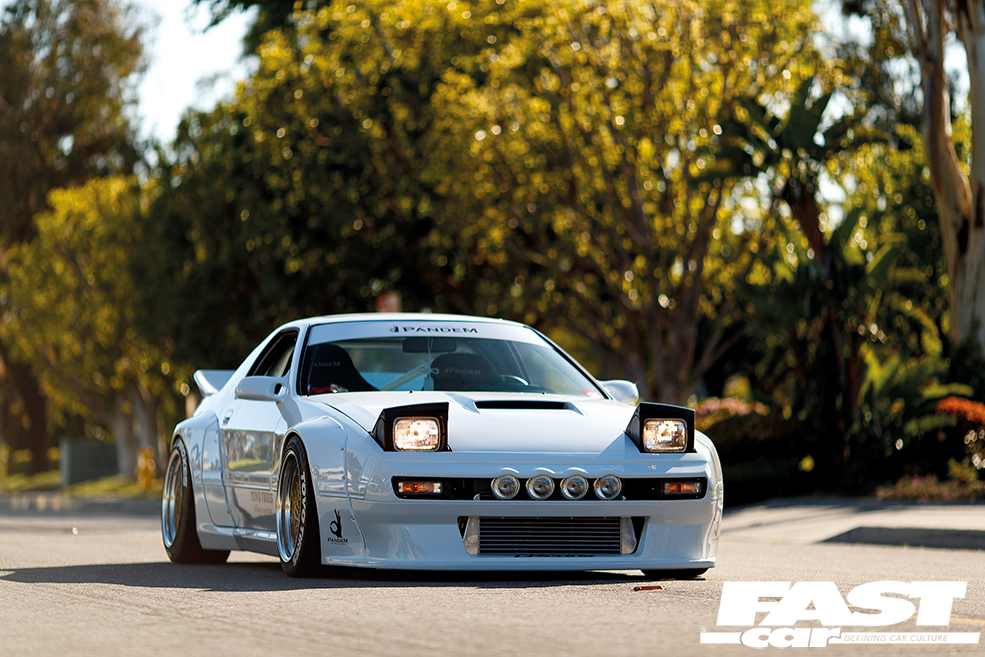
Mazda RX-7 FC Transmission Tuning
The FC RX-7 gearbox and rear differential setup come in two main variations: the naturally aspirated versions, and the turbo ones. The turbo ones are strong and capable of handling big power increases without too much hassle, and the naturally aspirated gearbox and differential are closer to the Mazda MX-5 setups, which isn’t to say they are super weak, but the turbo parts, or aftermarket upgrades, are the way to go.
Gearbox
The factory FC Turbo gearbox is internally very similar in design and strength to the later FD box, but the shift feel tends to be notchier than the later model boxes. FD boxes aren’t a direct fit to the FC unfortunately, but there are kits to allow you to do so, which is mostly useful for people who struggle to find good condition FC boxes to use!
Gearbox upgrades exist, and range from uprated gear sets for the standard box like the OS Giken kit, gearbox swaps to the strong but agricultural T56 gearbox, sequential gearboxes, and now there’s even a conversion kit available to run the BMW paddle shifted DCT transmissions on rotary engines.
Differential
Depending on model, there’s a variety of differential types in FCs. The naturally aspirated versions come with either an open diff or viscous LSD, and the turbo versions all had limited slip differentials, some being a clutch type, some a torsen style.
Thanks to the FCs long history in motorsport, not to mention interchangeability with other differentials, there’s a good variety of ring and pinion ratios available for the FC rear diffs, allowing you to change the gearing to suit your needs.
Aftermarket clutch type LSDs are widely available for the turbo rear ends, giving improved traction over the standard LSDs, at the expense of some mild noise and drivability issues as plate style diffs can be a little clunky during low speed cornering.
For cars with massive amounts of power and grip that can’t keep the standard rear end in one piece, there’s plenty of complete conversions for the FC out there, from Ford 8.8 swaps keeping independent rear suspension, to full solid axle rear ends as favored on most drag cars.
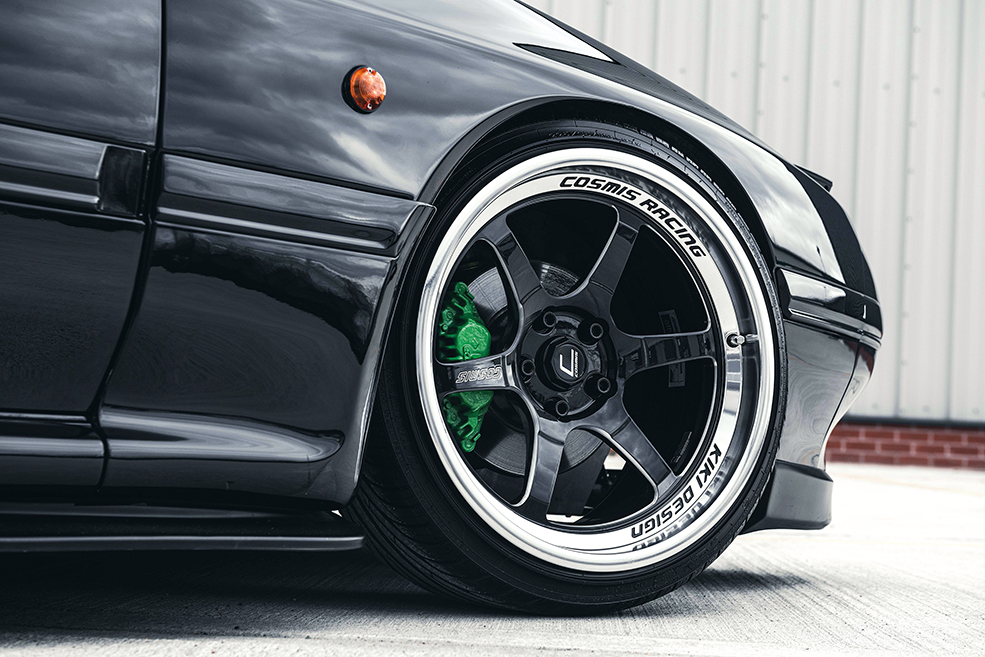
Mazda RX-7 FC Brake Tuning
The standard brakes on the turbocharged FC are actually very good for a car of this era, with beefy 4pot front calipers which, especially combined with some uprated pads, do a good job of stopping even big power cars.
For hard track use though, or just for awesome looks, even bigger is available. While not as many kits exist for the FC as they do the FD, Rotora, Racing Brake, Wilwood, K-Sport, and many more do direct bolt on big brake conversions for these cars.
Mazda RX-7 FC Suspension Tuning
Like all models of RX-7, the FC is a great handling and nimble car from the factory, and they don’t need huge changes to make a drastic improvement either, and thanks to its long term and widespread use in motorsport, there’s plenty of upgrades available.
A simple set of coilovers with adjustable top mounts are a great upgrade to both the handling and ride height. Brands like HSD and BC Racing being the most commonly found these days, but if you want to do some online digging, countless top manufacturers in Japan produce suspension kits for them, and you will even find suspension by non-Japanese brands that you normally only see sold in the FCs homeland, such as Ohlins.
It’s worth noting that the FC came from the factory with a form of passive rear steering which in all honesty is best off being deleted to give a more predictable driving experience. This, plus replacing the commonly worn out rear diff mount with a solid item really freshens up the handling feel of a FC. All these parts, and many more, are all available from Parts Shop Max, which really is a one-stop shop for FC RX-7 suspension upgrades.
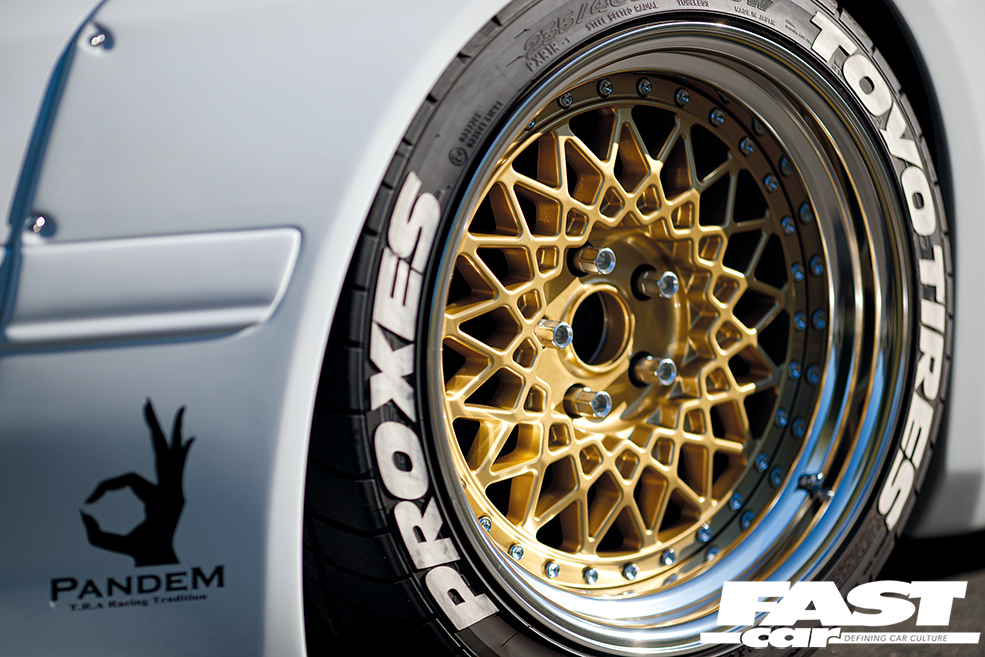
Mazda RX-7 FC Wheels and Tires
While they’re lightweight and great quality, the OEM 15in BBS wheels most commonly found on FC RX-7s certainly do date the car, and even if you don’t mind the looks, to fit wide tires to match a serious power upgrade, changes need to be made.
On factory arches you’re quite limited to what you can fit, especially at the front, where a 225 wide tire and an 8inch wide wheel is pretty much the maximum that will fit without modifications. The rear isn’t so bad, where people have fitted 255 wide tires on 9in wide wheels while still on standard arches.
Beyond standard arches, the world is your oyster. Even with heavily rolled and flared standard arches we’ve seen as much as 265 wide front and 295 wide rear tires on FC Time Attack cars in Japan, and with a set of wider arches front and rear, we’ve see 295 front tires and 315 rears!
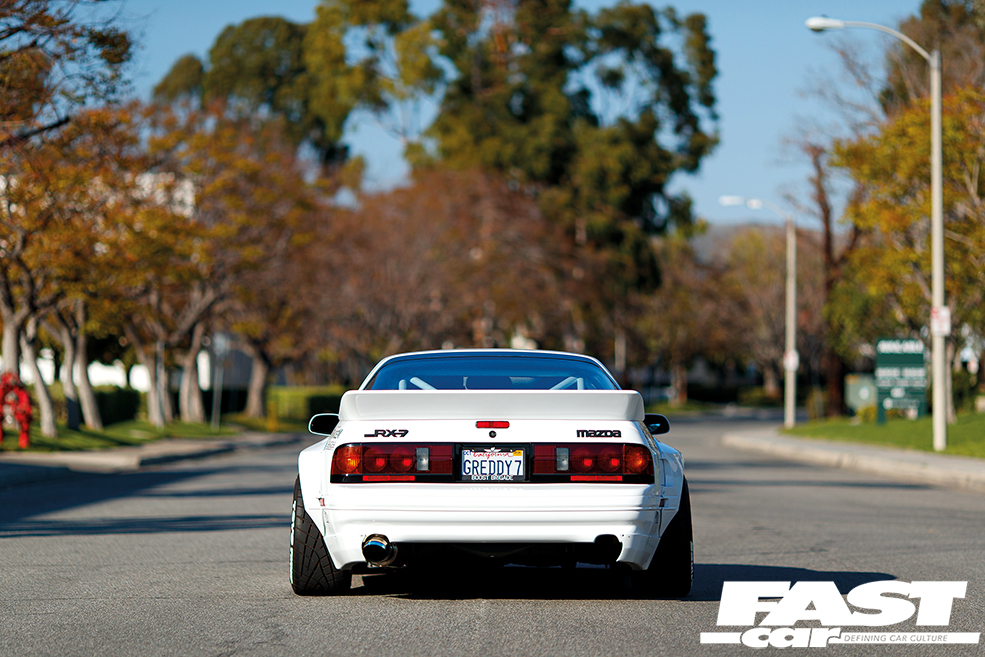
Mazda RX-7 FC Styling upgrades
The FC RX7s looks have dated very well in recent times, and it’s became a very cool looking retro sports car, but it’s also a car where aftermarket body modifications transform the look so much that it’s very rare for any highly tuned FC not to have the bodywork to match.
Body Kits
The most popular styling upgrade is wider front and rear arches, which both transforms the looks by giving the normally rather narrow body a much more aggressive look, and allows much easier fitment of wider wheels and tires. There’s various styles out there, but the BN Sports style wide arches are the most commonly seen, and for good reason too; they suit the car perfectly.
There’s been literally dozens of full body kits made over the years in Japan for the FC. BN Sports, Foresight, GP Sports, R Magic, and Sexy Style all make great looking and popular kits for the FC, but that is just a fraction of what’s out there!
Lightweight Panels
Away from pure looks, thanks to the widespread use of FCs in motorsport, if you’re prepared to search for them, almost every part on the car can be purchased in a lightweight race version. Aftermarket rear hatches made of fiberglass and lexan, carbon doors; you name it and it exists somewhere for the FC.
Rear Lights
The last thing to be aware of on the FC is the rear light differences. S4 and S5s have different style rear lights, which most people preferring the S5 style, but there’s more to it than that. UK spec rear lights are actually narrower than Japanese and US spec rear lights to allow for the longer number plates we have here, so while at first glance they look the same, most agree the US/Japan rear lights look much better, so if you have a UK car and you get a chance to buy some of the USDM/JDM lights, snap them up for an easy bolt-on upgrade.

